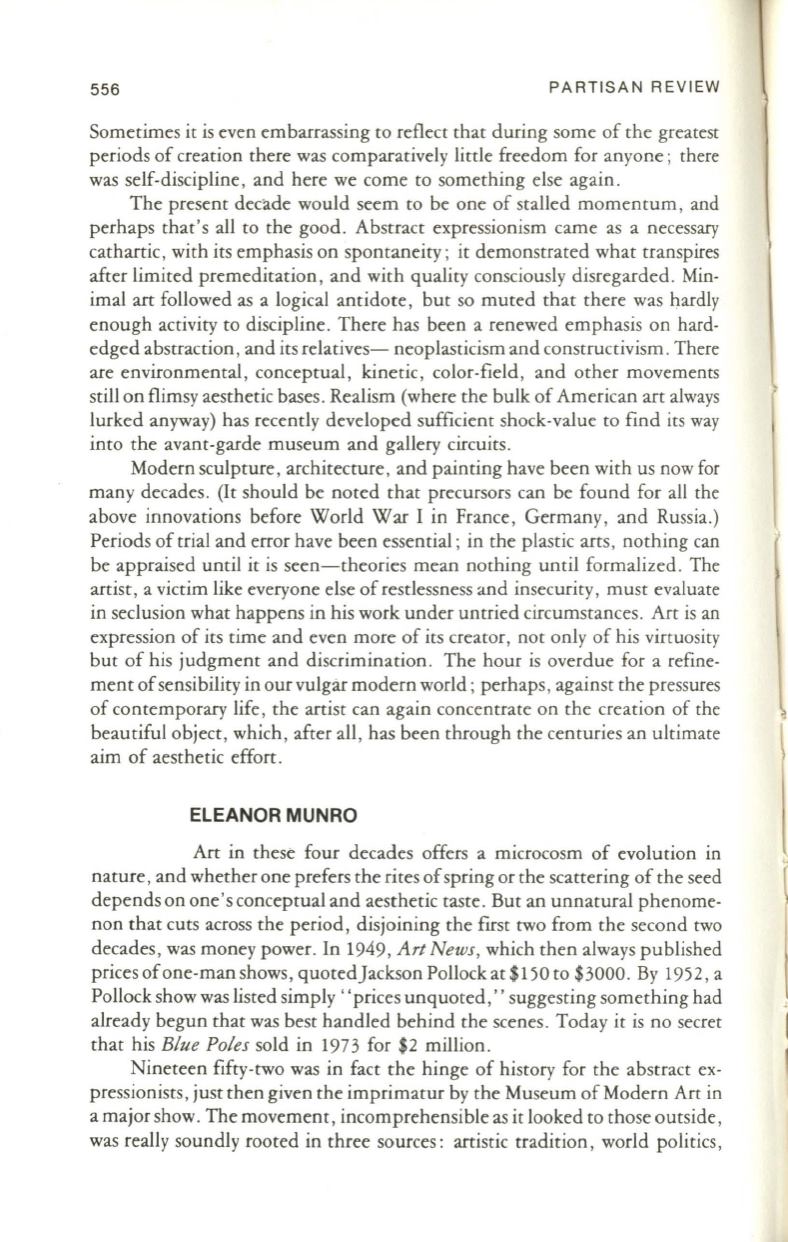
556
PARTISAN REVIEW
Sometimes it is even embarrassing to reflect that during some of the greatest
periods of creation there was comparatively little freedom for anyone ; there
was self-discipline, and here we come to something else again.
The present decllde would seem to be one of stalled momentum , and
perhaps that's all to the good. Abstract expressionism came as a necessary
cathartic , with its emphasis on spontaneity ; it demonstrated what transpires
after limited premeditation , and with quality consciously disregarded . Min–
imal art followed as a logical antidote , but so muted that there was hardly
enough activity to discipline. There has been a renewed emphasis on hard–
edged abstraction, and its relatives- neoplasticism and constructivism . There
are environmental, conceptual, kinetic, color-field , and other movements
still on flimsy aesthetic bases . Realism (where the bulk of American art always
lurked anyway) has recently developed sufficient shock-value to find its way
into the avant-garde museum and gallery circuits .
Modern sculpture , architecture , and painting have been with us now for
many decades.
(It
should be noted that precursors can be found for all the
above innovations before World War I in France, Germany, and Russia.)
Periods of trial and error have been essential ; in the plastic arts , nothing can
be appraised until it is seen-theories mean nothing until formalized. The
artist, a victim like everyone else of restlessness and insecurity , must evaluate
in seclusion what happens in his work under untried circumstances . Art is an
expression of its time and even more of its creator , not only of his virtuosity
but of his judgment and discrimination. The hour is overdue for a refine–
ment ofsensibility in our vulgar modern world ; perhaps, against the pressures
of contemporary life, the artist can again concentrate on the creation of the
beautiful object, which, after all, has been through the centuries an ultimate
aim of aesthetic effort.
ELEANOR MUNRO
Art in these four decades offers a microcosm of evolution in
nature , and whether one prefers the rites ofspring or the scattering of the seed
depends on one's conceptual and aesthetic taste. But an unnatural phenome–
non that cuts across the period, disjoining the first two from the second two
decades, was money power. In 1949,
Art News,
which then always published
prices ofone-man shows, quotedJackson Pollock at $150 to $3000 . By 1952 , a
Pollock show was listed simply' 'prices unquoted," suggesting something had
already begun that was best handled behind the scenes . Today it is no secret
that his
Blue Poles
sold in 1973 for $2 million.
Nineteen fifty-two was in fact the hinge of history for the abstract ex–
pressionists, just then given the imprimatur by the Museum of Modern Art in
a major show. The movement, incomprehensible as it looked to those outside,
was really soundly rooted in three sources: artistic tradition, world politics ,


